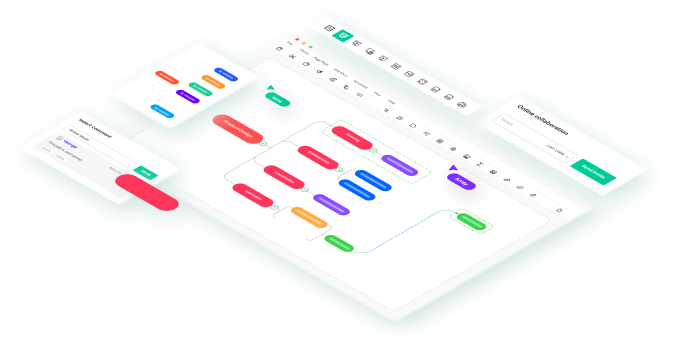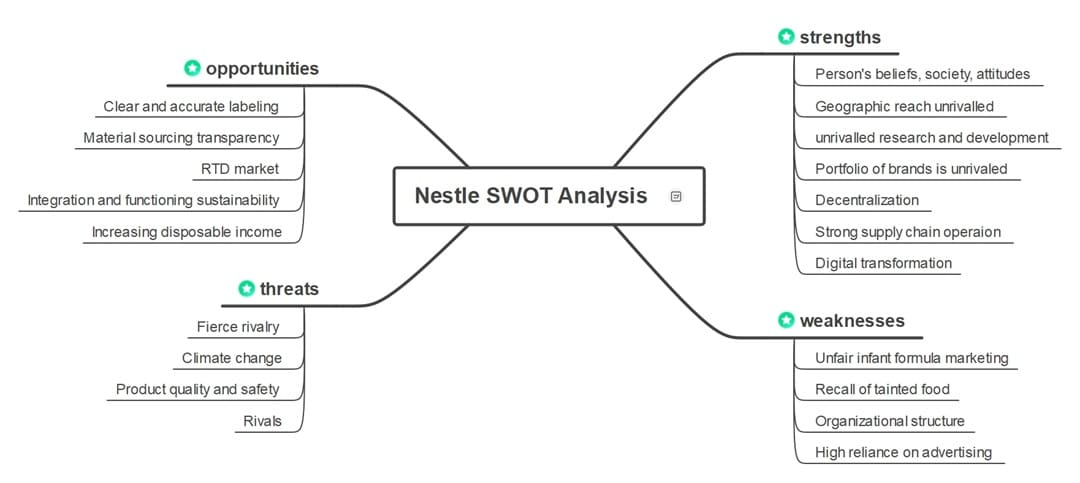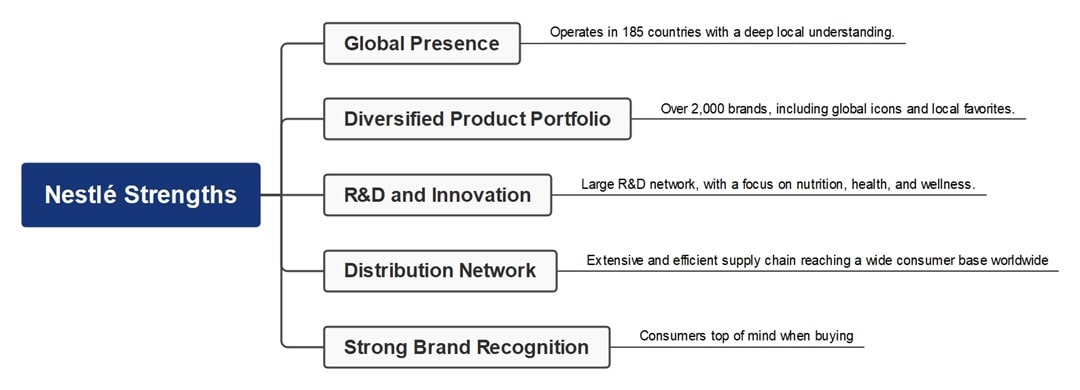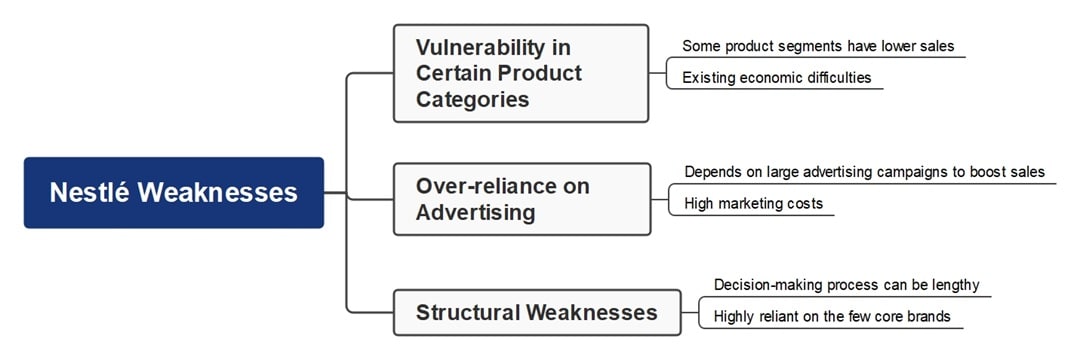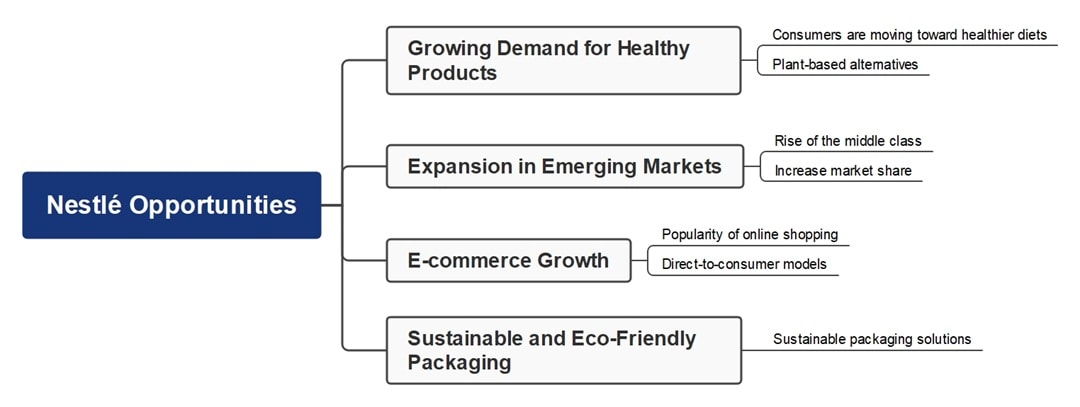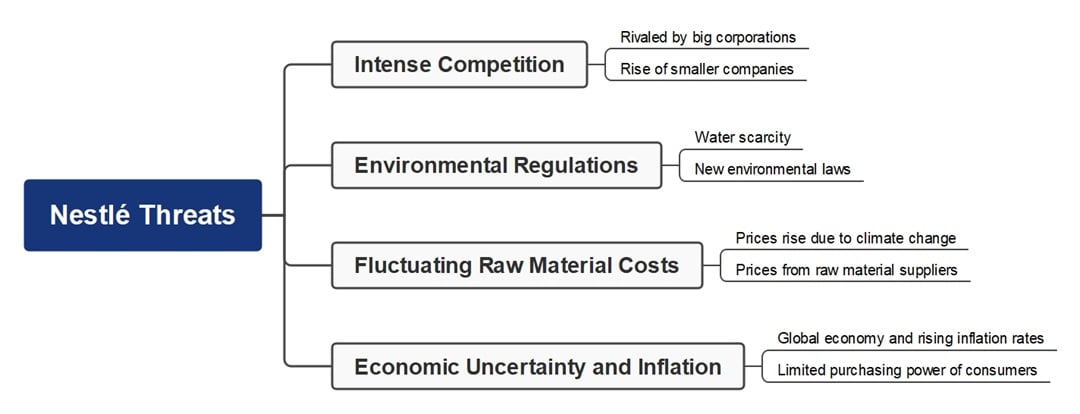A Nestlé SWOT analysis identifies the firm’s internal strengths and weaknesses along with opportunities and threats. Performing a SWOT analysis paints the complete picture of the enterprise in question. Essentially, it reveals to you what Nestlé is good at and what obstacles it faces. Plus, there is potential for expansion. If you want to learn about the Nestlé SWOT analysis, then keep reading. You can first see a quick overview of Nestlé’s key facts and figures.
In this article
Overview of NestléCompany
Nestlé is a company that was established in 1866 by Henri Nestlé in Vevey, Switzerland. Currently, it is a corporation that ranks first among the world’s food and beverage companies. The company's mission is to unlock the power of food to improve life for everyone. Somehow, in time, Nestlé has become known for far more than just the original products of the company.
After reviewing Nestlé’s SWOT, it can help to see all the information in one place. A mind map lets you lay out strengths, weaknesses, opportunities, and threats visually.
The list of its brand names will involve such product categories as chocolate, coffee, bottled water, baby food, and pet care. Hence, the company has become very popular among consumers. Consequently, Nestlé has elevated its brand from offering good products to being a guarantee of quality and good customer service. Next, you can check the table for key facts about Nestlé:
| Aspect | Information |
| Global Headquarters | Vevey, Switzerland |
| Employees | Over 277,000 globally |
| Group Sales | CHF 91.4 billion (2024) |
| Organic Sales Growth | 2.8 % (As of April 2025) |
| Global Presence | 185 countries |
| Key Segments | Powdered and liquid beverages, water, milk products, ice cream, nutrition, health science, prepared dishes, cooking aids, confectionery, and pet care. |
| Official Website | Nestle.com |
Nestlé Strengths
Nestlé`s strengths refer to those internal factors that provide it with a competitive advantage. These are the resources and capabilities that are so strong that they put it way ahead of other companies in the worldwide market.
Unmatched Global Presence and Distribution Network
Nestlé operates in 185 countries, allowing it to reach consumers across the globe. Its decentralized strategy enables it not only to follow the local preferences but also to respect its customs. This virtue provides Nestlé with a distinct advantage over other competing firms.
Furthermore, the company has a massive distribution platform that delivers the product not only to urban areas but also to rural areas. As a result, Nestlé products remain largely present and highly accessible to consumers.
Extensive and Diversified Product Portfolio
It is one of the companies that can be proud of having the most diverse product portfolio in the food sector. It covers over 2,000 different brands, such as Nescafé, KitKat, and Purina. This diversity reduces Nestlé’s relianceon a single product or market. In case you wonder what that means for the consumers, well, it means that there is most likely a Nestlé product that matches your needs or preferences.
Strong Brand Recognition and Customer Loyalty
Consistent presence in the market has gained Nestlé an untarnished name for quality and reliability. Consumers usually make the first choice to be Nestlé brands. As a result, it creates a strong customer loyalty. This branding power is an advantage to Nestlé in launching new products and retaining market share.
Robust Research and Development Capabilities
Nestlé invests in R&D, operating research centers worldwide. Through this, they can meet the market with emerging preferences. As a result, Nestlé stays ahead in trends like healthier options and sustainable packaging.
Financial Stability
Nestlé has good financial health and strategic investments. This helps with the acquisition of other companies. Aside from that, its economic stability serves as a buffer against market decline. Thus, the company can manage the accompanying risks while still seizing the opportunities if available.
Nestlé Weaknesses
While Nestlé dominates the food and beverage industry, it faces several challenges. Here are some of its weaknesses:
Vulnerability in Certain Product Categories
The company has some product segments, for example, sauces and condiments, that have lower sales compared to the same segments of rival companies. Also, the slow sales rate in some markets is a reflection of the existing economic difficulties and the rivalry that has become stiffer. These areas make Nestlé vulnerable to market movements and consumer choices.
Over-reliance on Advertising
Nestlé depends on large advertising campaigns to boost sales and maintain visibility. This approach creates high marketing costs. The result is a risk if campaigns fail or if consumers move away from traditional media channels.
Structural Weaknesses
Due to Nestlé's large organizational structure, Nestlé's decision-making process can be lengthy. Besides, Nestlé is highly reliant on the few core brands such as Nescafé and KitKat, through which it derives most of its revenue. Such dependence puts the company at risk if consumer preferences or market trends change.
Nestlé Opportunities
Opportunities are positive external factors that Nestlé can take advantage of to improve its competitive positioning. These are areas where the company can deepen its expertise, bring new ideas, and increase its impact.
Growing Demand for Healthy and Plant-Based Products
Consumers are moving toward healthier diets and plant-based alternatives. Nestlé can use its R&D to create new products and increase offerings. So, the company not only satisfies changing tastes but also accesses a high-growth market. The outcome will be a more robust portfolio that attracts the health-conscious and environmentally friendly consumers.
Expansion in Emerging Markets
Emerging economies offer a lot of untapped potential to Nestlé. The rise of the middle class in areas such as the Asia Pacific and Latin America is a primary driver for the demand for branded food and beverages. Nestlé can use its worldwide footprint and distribution to reach its consumers and increase its market share.
E-commerce Growth
The popularity of online shopping and direct-to-consumer models is still rising. Nestlé might well support the setting up of a digital platform that would allow it to expand its client base. Also, it can help to streamline the supply chain and gain access to consumer data. Consequently, Nestlé can catch up with the latest trends and offer a more tailored service.
Sustainable and Eco-Friendly Packaging
Consumers are more concerned with the environmental impact of their purchases than ever before. Nestlé has a wonderful chance of being the leader in the adoption of sustainable packaging solutions. By doing so, it not only renews the brand's appeal but also pulls in more market who consider sustainability as a priority.
Nestlé Threats
Threats are the external or environmental factors that are adverse to the business model of Nestlé. The company must be a step ahead in alleviating these difficulties to maintain its market position.
Intense Competition
The food and beverage market is global and extremely competitive. Nestlé is rivaled by big corporations such as Unilever and Kraft Heinz, as well as small local brands. Consequently, prices can be under pressure and the share of the market may vary. What Nestlé should do is to innovate and keep firm brand loyalty to be on the winning side.
Environmental Regulations
Nestlé is a company that often relies on water for its production. The rise of water scarcity, along with the tough environmental laws, may increase the costs of operation. However, these challenges can also give the company a reason to make a commitment to sustainability for both the resources and its image.
Fluctuating Raw Material Costs
The price for cocoa, coffee, and milk could go drastically with climate change or political events in the region. Such a situation destabilizes the profits of Nestlé. That means the company needs to be careful in its planning and take the right hedging positions to cut down on financial risk.
Economic Uncertainty and Inflation
Slowing of the global economy and rising inflation rates could have an impact on how much consumers are willing to spend on goods that they do not necessarily need. The impact will be stronger in developing countries, where consumers are more concerned about prices. As a result, Nestlé's turnover could fall if the company does not make changes in price or product strategies.
How To Make a SWOT Analysis Mind Map of Nestlé
In doing so, you can spot relationships and get a better grasp of the company’s stance.
Use a Professional SWOT Mind Map Maker
Wondershare EdrawMind makes creating a SWOT mind map easier. It offers templates, a simple interface, and multiple export options. The tool lets you adjust the mind map as your analysis changes. This is a great tool for students, investors, or anyone researching Nestlé, as it can convert the detailed study into a simple visual summary.
At the same time, it helps you organize thoughts, track insights, and share your findings in presentations or reports.
Steps To Make a SWOT Analysis Mind Map
Step 1: Create a Mind Map
Open the software and click New Mindmap to start.
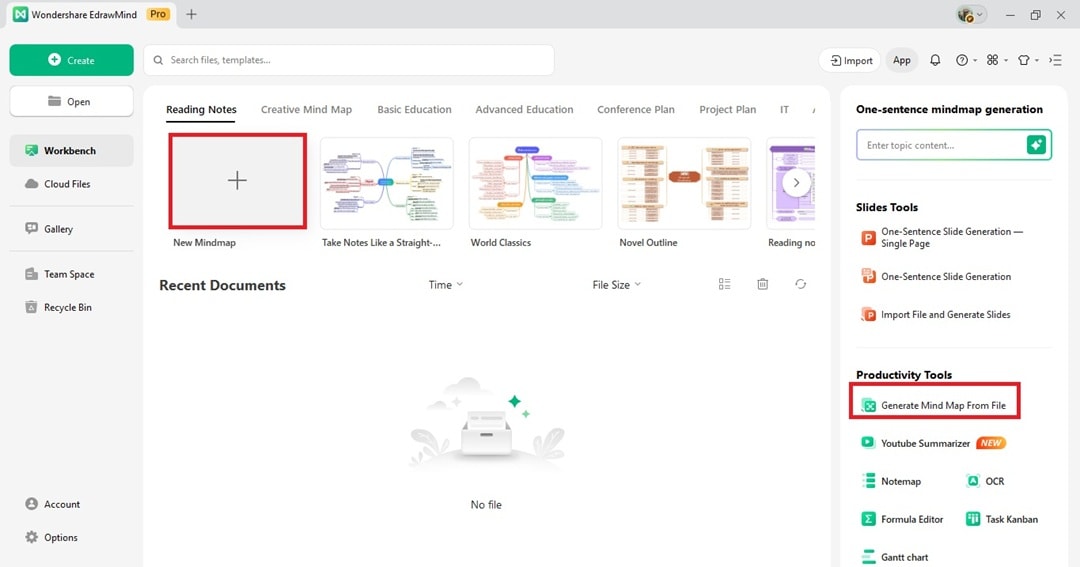
Alternatively, select a SWOT Analysis template. You can also upload a file to generate a mind map using AI.
Step 2: Add Branches and Sub-branches
Double-click the central bubble and name it "Nestlé SWOT Analysis." Label the four main branches as Strengths, Weaknesses, Opportunities, and Threats. For each main branch, add sub-branches and input the key points from your research.
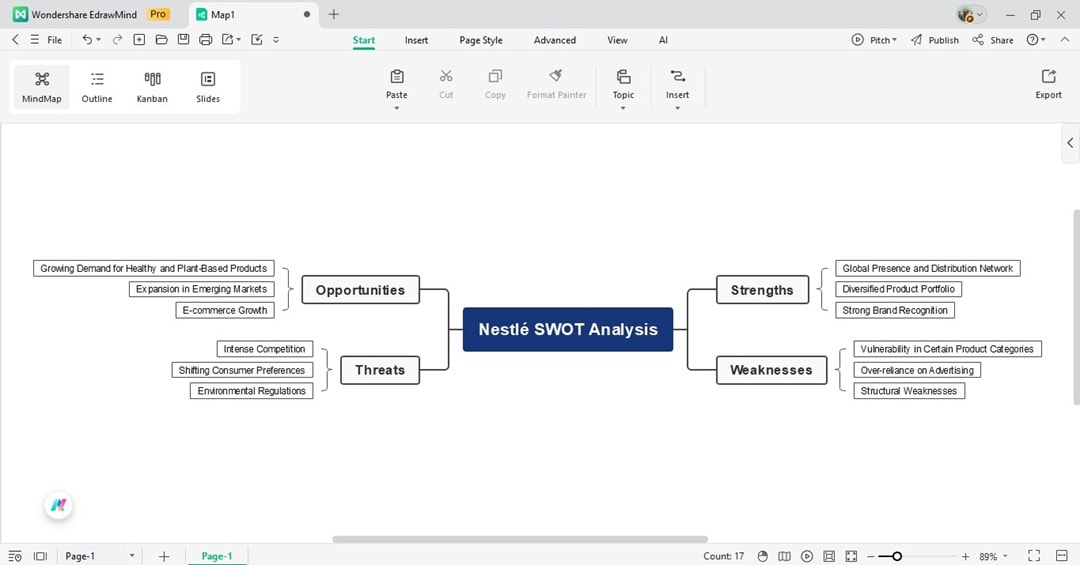
Step 3: Customize and Export
Open the right panel. From there, you can change the mind map layout, theme, add icons, and more.
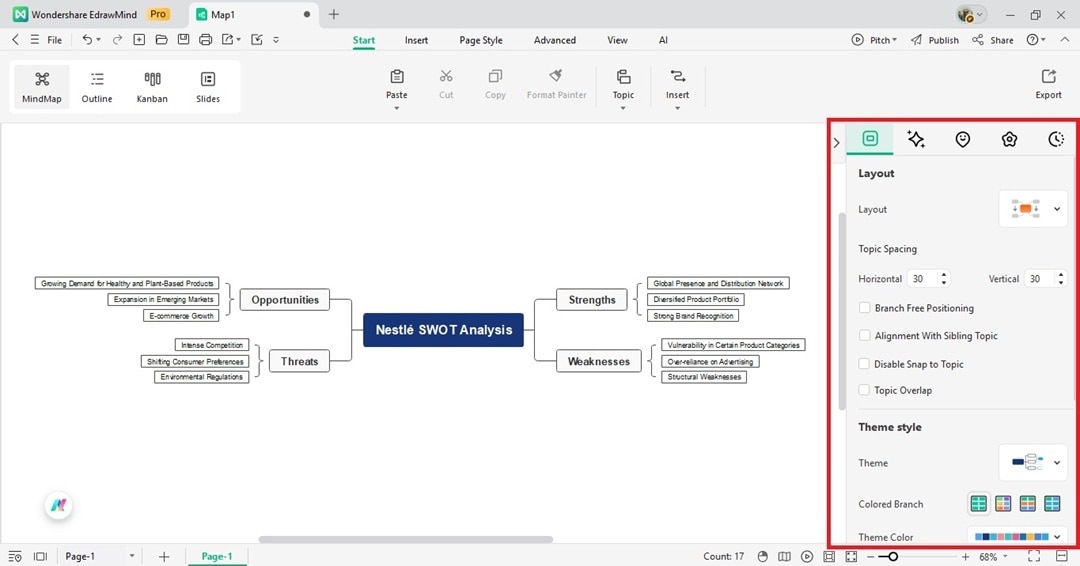
Export your mind map as an image or PDF.
Tips To Make a SWOT Analysis Mind Map for Nestlé
To make the mind map work well, do the following:
- Begin with research: Collect recent news about Nestlé, financial statements, and market trends.
- Make it pictorial: Represent ideas with icons, emojis, or small images.
- Order main elements: First, draw attention to either the vital strengths of the company or its largest threats.
- Write down in short sentences: Let each point be simple. It turns the map into a quick scanning and understanding tool.
- Practice and upgrade your map daily: The market of Nestlé is rarely the same. Keep your mind map updated so that it remains applicable.
- Try out different styles: Experiment with radial, tree, or matrix styles to find out which one allows better visualization of the connections.
FAQ
-
What Are the Competitive Advantages of Nestlé?
One of such factors is Nestlé's portfolio of globally established brands. The company has an extensive and highly effective distribution system that covers a large portion of the market. It is also a world leader in R&D, which supports its product development. The financial stability of Nestlé gives it a solid foundation for strategic growth. -
What Is the Strategy of Nestlé?
The focus of Nestlé’s strategy is healthy and good living through food. It highlights the components of nutrition, health, and wellness. The company is keen on environmental trends and consumer patterns, and it makes ecological investments. Nestlé aims to produce delicious, nutritious, and affordable products. -
What Is Nestlé's Business Model?
Nestlé uses a Creating Shared Value (CSV) business model. This model considers creating value for shareholders as well as for society. The work they have done to save water is a good example of how this company has put its CSV approach into practice. This approach guides its work in water stewardship, rural development, and health and wellness. These efforts also boost the company’s reputation and support long-term growth.



